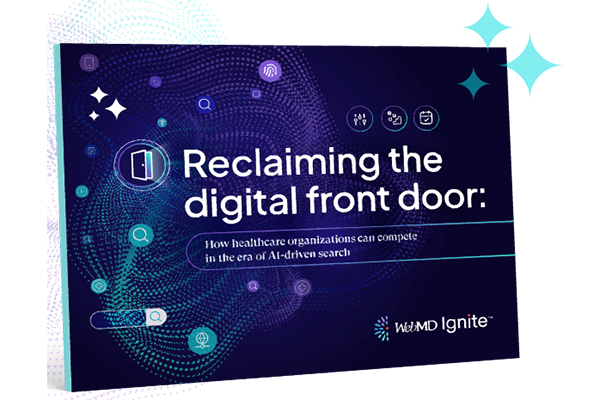Transform Your Healthcare Marketing Department into a Center of Excellence

Categories: health plans, health systems, healthcare organizations, associations
Editor's Note: This blog was published prior to the transition to WebMD Ignite.
There are hundreds of reasons to rethink a hospital marketing team strategy or structure, but perhaps none better than this simple realization: Our campaigns aren’t making an impact.
In today’s healthcare landscape, the old, traditional tactics won’t cut it, nor will simply dipping your toe into digital advertising. Similarly, neither will old, traditional (read: siloed) structures.
Increasing demand for better experiences in healthcare
Healthcare consumers demand experiences not all that different from what they get from disruptive brands in retail – like Amazon, Apple, and Trader Joe’s. They can pick and choose the providers they see and hospital facilities they use based on previously ‘healthcare-irrelevant’ factors, such as convenience, atmosphere, and degree of personalization. In other words, customer experience matters.
As a result of this shift in consumer expectations, healthcare marketing has found itself in a tumultuous state. Small teams of “generalist” marketers who are singlehandedly responsible for branding, advertising, PR, data analysis, and campaign execution are no longer sufficient. Today’s healthcare marketing team needs to employ leaders with a variety of skills and highly specialized responsibilities – as well as a handful of key technologies and precise data analytics to guide their strategy.
Moreover, marketing is no longer limited to the marketing team: It has to extend into other realms, including sales, strategic planning, and the call center, in order to be truly effective. Keeping different departments penned off into their own corners, unaware of each other’s (often overlapping) goals or efforts, is a recipe for a poor patient experience.
Modern-day healthcare marketing is desperately in need of change. To remain competitive, it’s time to change, engaging the right leadership in the process. Let’s take a look at a few key strategies to guide the transformation from marketing department to modernized, revenue-producing marketing center of excellence.
Eliminate silos in your healthcare organization
One of the most significant barriers to marketing efficiency has to do with the way in which marketing departments are often walled off from other functions within a healthcare organization. Marketing can no longer be considered a discrete entity: Healthcare marketers’ work touches all other aspects of the health system, from technical operations to physician outreach to ongoing patient relations. Therefore, marketing efforts must be determined based upon larger organizational strategy – if not, campaigns won’t make sense or fit into big-picture goals.
When reorganizing marketing team structure, cross-departmental collaboration needs to be a key focus. Healthcare marketing officers should act as a conduit to bring marketing, the engagement center (or call center), business development, and strategic planning teams together. Employees (including marketers) should be unified around a common vision and actively engaged in shaping long-term strategic goals and strategy.
It’s important to remember that while internally we organize around department structures, to the consumer, it’s all the same entity. Consumers don’t think of marketing, sales, and support as different “things.” This is true regardless of the size or scope of the organization.
Similarly, healthcare marketing data should be released from silos and integrated into centralized platforms, such as an CRM. In doing so, marketers can provide other critical teams with access to important insights around patient relationships, population trends, and consumer preferences. Such access can have a significant impact on brand voice and consistency, especially when shared across departments.
Likewise, other teams should begin sharing access. Marketing strategy is better when informed not just by consumer insights, but also by broader market dynamics and activities, such as an understanding of physician referral patterns. The same is true for business development teams who gain access to marketing insights: The sharing of data fills in important gaps in organizational knowledge.
Keep your healthcare organization agile
Flexible roles and fluid job responsibilities allow healthcare organizations and marketing teams to work with greater agility – often improving employee satisfaction.
Many healthcare organizations may have limited resources with which to hire a robust team of highly specialized marketers, but they’re still better off employing smaller numbers of trained specialists than a larger pool of generalists.
Case in point: The Harvard Business Review evaluated a comprehensive study on some of the most successful marketing organizations around the globe.1 They found that it was more advantageous to categorize marketers not by their job titles but, rather, by how they fit into three broad categories. The categories are explained as follows:
- ‘Think’ marketers, who apply analytic capabilities to tasks like data mining, media-mix modeling, and ROI optimization;
- ‘Feel’ marketers, who focus on building the system’s brand, developing content, and communicating meaningful patient stories; and
- ‘Do’ marketers, who focus on consumer interaction and highly focused engagement in roles from customer service to social media and online communities.
After grouping team members into these categories, healthcare organizations can employ an ‘orchestrator model’ to put together cross-functional teams composed of a balance of these three types of talent. This way, every project has the right mix of support to succeed, even under challenging circumstances.
Optimize the patient experience
Increasing competition from traditional healthcare providers as well as new, non-traditional entrants creates an opportunity to focus on customer experience as a competitive advantage. The future of the industry as a whole, in fact, lies in its ability to move beyond just providing consistent, high-value care to patients at the moments when they need it most. Instead, it’s about replacing that model with a holistic, high-touch system consisting of ongoing care and proactive touchpoints.
Marketing teams have substantial, but often overlooked, influence over the customer experience as a whole: Marketing is often the reason a consumer first becomes aware of a health system, and marketing provides the content and materials for continuing education and awareness. As marketing tactics become more sophisticated and technologies more intricate, the data and insights will be readily available to gain a more robust understanding of consumers – with a nod to communication preferences and personal habits.
As noted previously, healthcare marketing is no longer its own discrete entity. It overlaps with many other functions and departments within a health system; as such, marketers are partially responsible for ensuring that the patient experience they convey via marketing materials is echoed during phone calls, provider interactions, and ongoing care.
An optimal patient experience involves interactions that provide three different types of benefits: Functional, emotional, and societal. Marketers can use CRM data (overlaid with EHR data) to understand which of these types of benefits best speak to each target patient persona, and then communicate these insights to call center representatives, providers, and other health system staff.
In addition, an optimal patient experience begins with marketing that balances both breadth (i.e. the number and types of touchpoints) and depth (the degree of personalization) to create a dynamic, comprehensive experience that promotes ongoing engagement and, ultimately, improved health outcomes.
Final thoughts
I’ll conclude with another quote from the Harvard Business Review outlines the three key takeaways to keep in mind when considering marketing transformation in healthcare:
“The leaders of high-performing companies connect marketing to the business strategy and to the rest of the organization; inspire their organizations by engaging all levels with the brand purpose; focus their people on a few key priorities; organize agile, cross-functional teams; and build the internal capabilities needed for success.”
Today’s healthcare marketers need to be just as innovative, agile, and strategic as the top CMOs in other consumer-facing industries. Healthcare organizations can seek out inspiration from disruptive brands in retail, food and beverage, and even technology: Those who succeed are those who can create optimal customer experiences, leave memorable impressions, and maintain high levels of brand engagement and awareness.
In such a heavily competitive landscape, healthcare marketers must leverage all the resources and technology available to them to eliminate silos, reevaluate team structure, and improve cross-departmental collaboration. Only by taking these steps will marketing teams be able to prove their value to organizational leadership and reestablish themselves as drivers of revenue.




